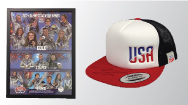Olympic Selection Procedures - Freestyle/FreeskiingWednesday, Jul. 31, 2013 |
||||||||||||||||||||||||||||||||||
|
Every four years, the USSA has the honor of selecting its Olympic Team. Given the strength of the USSA's athletes and teams, this selection process can be demanding on the athletes, and the stresses associated with Olympic selection are considered in the design of the selection procedures. Ultimately, the procedures are designed to build and select the most competitive Olympic Team possible, and to support the USSA's Vision of being Best in the World. The USSA's selection procedures primarily evaluate top-level international performance. They evaluate podium-level performances, and the frequency an athlete attains top-flight performance. The USSA brought 76 athletes to the 2010 Games in Vancouver, and will bring roughly 96-100 athletes to Sochi, attributable to the fact that five new events will be introduced during the Olympics there. All nations must earn the quota of athletes they are allowed to enter into the Olympics, based on a system defined by FIS and the IOC. This system takes into account the overall strength of each nation, assigning quotas based on that strength, as well as pre-defined total field sizes in many of the events. While the number of sports have been expanded, the total number of athletes has not been correspondingly expanded. While the IOC is eager to continue to modernize its program, it is also cognizant of the additional costs and complexity associated with the expansion of the number of events. And so while it works to keep the sport program relevant and modern, it is also working to contain the total number of athletes, coaches, and officials who can take part. Freestyle skiing/freeskiing have been most impacted by this balance, both positively and negatively. FIS and the IOC made very positive developments by adding the sports of halfpipe skiing and slopestyle skiing – both highly relevant, youth oriented events. These events have a large participation base, are dynamic and interesting for spectators and TV viewers, and will create a high degree of youth engagement in the Olympics. However, their addition has also created some challenges. The maximum number of athletes that a nation can enter in freestyle events in the Olympics is 26. With the ability only to enter a maximum of 26 athletes across five sports (moguls, aerials, skicross, slopestyle and halfpipe) and two genders per sport, it is highly likely that the USSA will be forced to leave a "podium potential" athlete at home. The performance levels of the athletes in these sports is very high, with multiple podium potential athletes in each sport and gender. In order to manage these levels of performance within the maximum allowable quota, and to field the most competitive team possible across all five sports, the USSA has designed a selection process that rewards top-level performance, and that also contextualizes the sport-by-sport selections by assessing the most recent performance levels of each sport as a whole. By capping the number of athletes in each sport who can be selected objectively based purely on the achievement of multiple podium finishes in international competition (based on the number of top international performers in each sport from the previous season), the ability to fill remaining positions on the team with the next most competitive athlete across sports is preserved. Specifically, up to five positions (assuming the USSA earns its maximum quota of 26) are reserved for evaluation across sports, giving the USSA the opportunity to select its next most qualified performers from across the five sports, yielding the most competitive team possible. This system has also been in place since 2006 in snowboarding, where a similar but less selective) quota limitation exists. This system has proven to be highly effective in selecting both the most qualified athletes, and the most competitive team. Luke Bodensteiner - EVP, Athletics |
Recent Blogs
|

